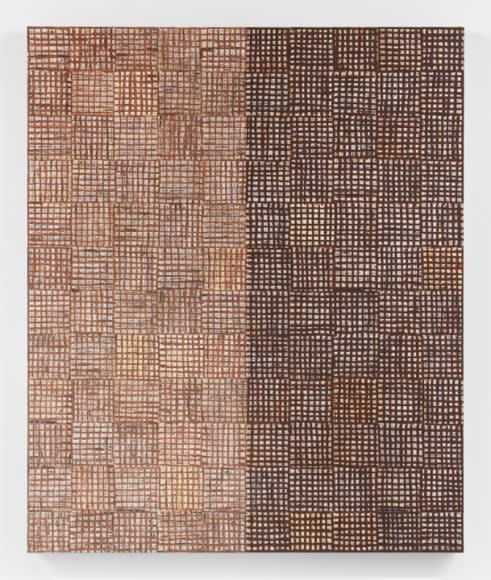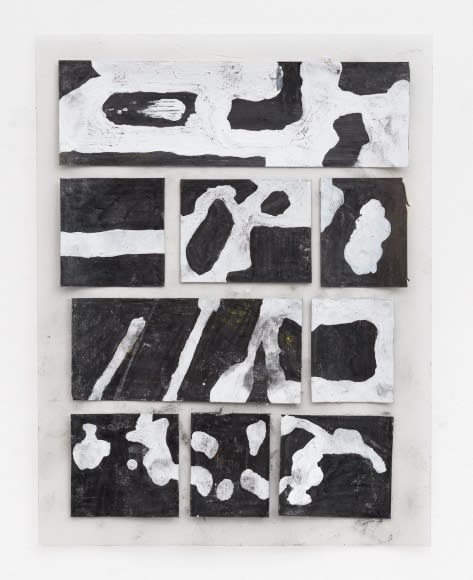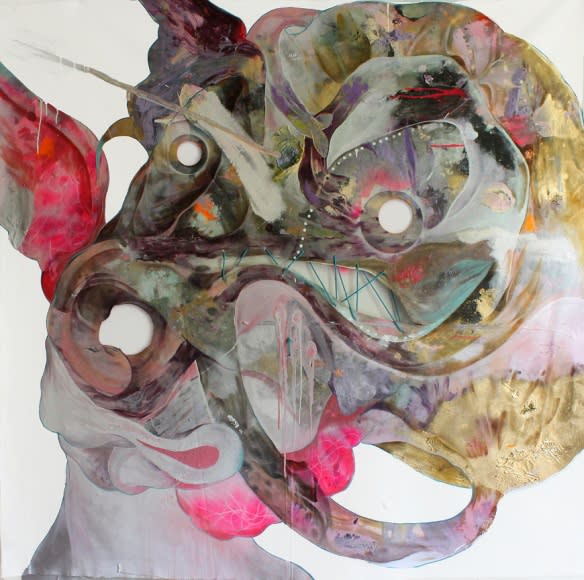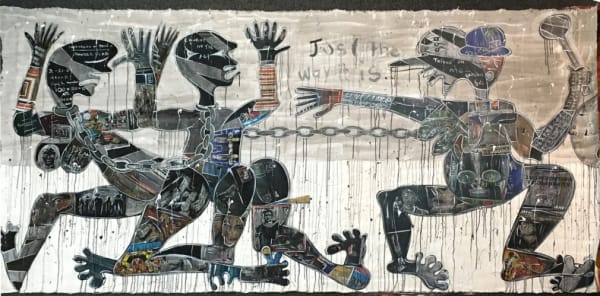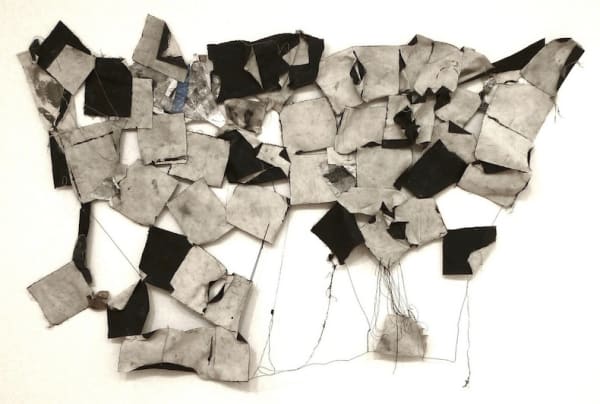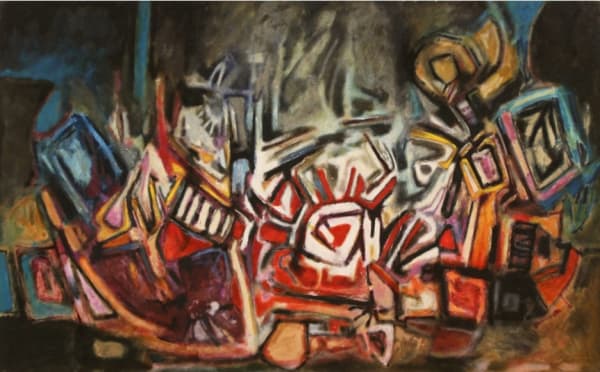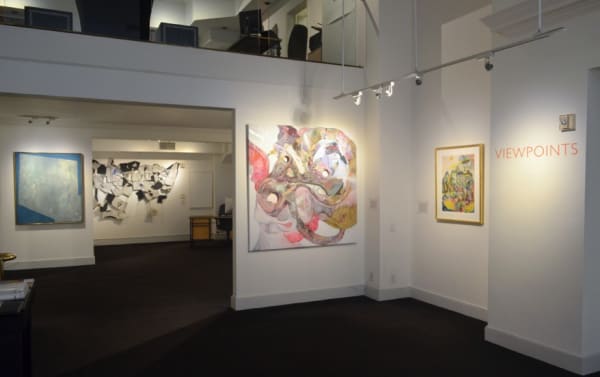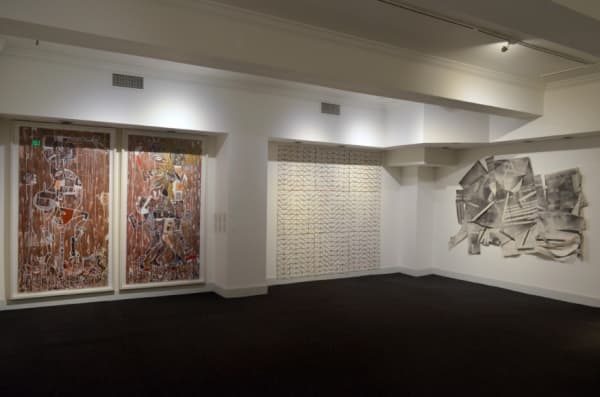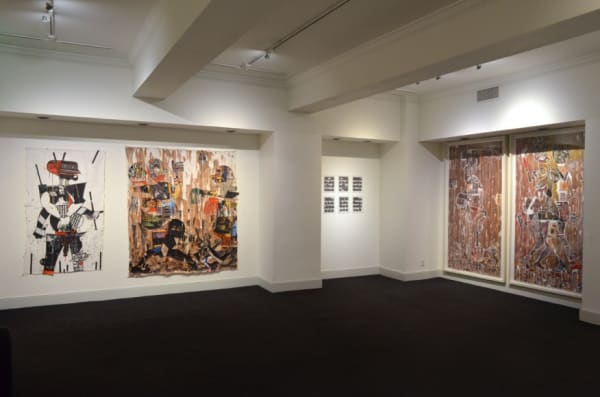Viewpoints: Romare Bearden, Aubrey Williams, McArthur Binion, Cullen Washington, Nate Young, Lavar Munroe, Blessing Ngobeni, Tony Lewis, Johnathan Payne
With grids, abstract figures, texts, and found objects, the artists of “Viewpoints” expand the parameters of expressive practice. Titles provide hints about the topics and themes that interest, if not preoccupy these makers. Yet above all, the creative imperative is to communicate ideas that can be taken in when looking at and experiencing painting, drawing, collages, sculpture, assemblage, and installation art. These projects demonstrate artistic commitment to materials, which are acted upon: strategic cuts, emotive drips, built up surfaces, and provocative juxtapositions are the outcomes of measurable activities and signs of “doing." As the work of historical artists in “Viewpoints” demonstrates, the engagement with theoretical concepts and aesthetic problems is not a recently developed trajectory among artists of African descent. What is new is broader awareness and curiosity about it.
Exhibition Essay by Jacqueline Francis
With grids, abstract figures, texts, and found objects, the artists of “Viewpoints” expand the parameters of expressive practice. Titles provide hints about the topics and themes that interest, if not preoccupy these makers. Yet above all, the creative imperative is to communicate ideas that can be taken in when looking at and experiencing painting, drawing, collages, sculpture, assemblage, and installation art. These projects demonstrate artistic commitment to materials, which are acted upon: strategic cuts, emotive drips, built up surfaces, and provocative juxtapositions are the outcomes of measurable activities and signs of “doing." As the work of historical artists in “Viewpoints” demonstrates, the engagement with theoretical concepts and aesthetic problems is not a recently developed trajectory among artists of African descent. What is new is broader awareness and curiosity about it.
The creative practices of the New York artist Romare Bearden (1911-1988) were numerous, and each was summoned to convey the majesty of his chosen subject matter. A painter, collagist, cartoonist, printmaker, muralist, and costume and stage set designer, Bearden explored the physical properties of many artistic mediums, plumbing their potential for representing the energy of human experience. Intrigued by the breadth and depth of African, African-American, Caribbean, and European cultures, Bearden interpreted epic tales, religious themes and ritual, and everyday life with a storyteller’s flair.
As was Bearden, the Guyanese-born British painter Aubrey Williams (1926-1990) was a committed humanist informed by literary, musical, performative, and visual expressions. Williams’ work was influenced by sources he readily cited, among them Abstract Expressionism, pre-Lenten carnivals, Afro-Caribbean folktales, and Shostakovich’s atonal symphonies. Color was the most salient element of Williams’s vision: it is manifest in the analogous shades of his non-objective compositions and in the bright hues that define ancient Central and South American iconic forms.
Chicago-based painter McArthur Binion (born 1946) similarly investigates the emotional power of color, which he applies with oil stick and wax crayon to canvas, aluminum, wood, glass, or paper. Binion’s mediums register on, in, or through the differently textured surfaces, which are transformed into sites of action. While his preferred deployment of one, two, or three hues at a time was once read solely as an austere Minimalist practice, Binion readily speaks of his works’ dialogic and symbolic aspects: they announce the facts of his artistic labor and they reference the landscape of his home state of Mississippi, to which he remains connected.
The linked structures of life’s networks and those of the gridded modernist painting are acknowledged and then breached in Cullen Washington’s mixed media art. For Washington (born 1972), pictures lend themselves to interruption, disruption, and expansion. The Brooklyn-based artist cuts up canvas, re-arranges it on the gallery walls and floor, and incorporates found material that adds to the sculptural quality of his large assemblages. Abstract, conceptual, material, and realist aptly describe these complex constructions whose layered and multiple meanings are derived from their very forms.
Nate Young’s untitled sculptures—designed, built, and refined by the artist’s skilled hands—find their analogies in the language system and structures that intrigue him. These crafted oak frames and cabinets are niches for Young’s graphite drawings—delicate, atmospheric abstractions and diagrams related to the linguistic philosophy of Ferdinand de Saussure. A sturdy pulpit further inspires consideration of discourse, in particular, religious sermons scripted and delivered by Young’s theologian father. By installing such symbolic objects poetically and critically, the Minneapolis-based Young (born 1981) decidedly puts language in its place.
Surrealist drawings and mixed media objects populate the fantastic environments produced by Lavar Munroe (born 1982). The Bahamian artist seeks to capture the alienating spectacle of the cross-cultural exchange gone bad. Notorious examples were the European and American nineteenth- and twentieth-century ethnographic displays of “the other,” which included the exotic presentation of non-Western peoples. The social violence of such acts is exuded in Munroe’s sliced canvases, and in the wildly and boisterously painted bodies, themselves distorted, exaggerated, and grotesque.
The mixed media canvases of South African artist Blessing Ngobeni (born 1985) satirize the corruption of his country’s elite: exaggerated and simply rendered figures appear as slick operators who exploit the impoverished. With these mash-ups, Ngobeni joins a distinguished lineage of artists who dared to critique the status quo, among them Goya, Grosz, Ringgold, Haring, Chagoya, and Abney. In common with them, Ngobeni creates scenes of excess that are urgent warnings to wake from the nightmarish present and to design a more just and equitable future.
The authority of realistic drawing is harnessed to the force of written language in Tony Lewis’s large works on paper. The Chicago-based Lewis (born 1986) culls visual and textual content from the well of the familiar (cartoons and inspirational literature) and then strips down images and words, deracinating both in order to make them strange, foreboding, and hermetic. As abstractions of his selected sources, Lewis’ drawings are intimate, mark-making gestures. They prompt reflection on public and private statements to be analyzed for their multiplicities and their resistance to analysis.
Johnathan Payne (born 1990) demythologizes painting by using comic books as medium and as content. For his “Construction” series, Payne cuts pages of this popular format into strips, marries them with colored printer paper, and weaves the stands into intricate, large-scale lattices that are mounted on the gallery wall. Transformed, the funnies maintain their playful color scheme while offering the serious mien of late modernist painting. An interdisciplinary artist with a critique to level, Payne strikes two targets in one fell swoop: the elitism inherent in the opposition of high art versus low art and the heteronormative, patriarchal, and racialized ideologies that mainstream comics have historically proffered.
- Jacqueline Francis, Ph.D., the inaugural Robert A. Corrigan Visiting Professor in Social Justice in the College of Ethnic Studies at San Francisco State University for 2016-17, also holds an appointment at the California College of the Arts as Associate Professor in the Graduate Program in Visual and Critical Studies
-

Romare Bearden
The Gorge, c. 1956
watercolor on paper
26 x 20 1/4 inches
©Romare Bearden Foundation/licensed by VAGA, New York, NY.
-

McArthur Binion
dna: white painting, test for seasons: XII, 2016
oil paint stick and paper on board
48 x 40 inches
Courtesy McArthur Binion and Galerie Lelong, New York
-

Tony Lewis
No, go for the Don Johnson fuzzy look..., 2015
pencil, graphite powder, and correction fluid on paper and transparency
11 x 8.5 inches
-

Lavar Munroe
Fallen, Godspeed, Glory (Angel no. 2), 2016
acrylic, latex, spray paint, and string on unprimed canvas
60 x 60 inches
-

Blessing Ngobeni
Make Us Great Again, 2016
mixed media on canvas
64.5 x 126 inches
-

Johnathan Payne
Untitled, (DDCC), 2016
shredded comic books and adhesive
94 x 94 inches
-

Cullen Washington
Letters to God, 2014
canvas, house paint, wax, coated string, wire, tape, paper
60 x 72 inche
-

Aubrey Williams
Shostakovich Quartet no. 15, Opus 141, 1981
oil on canvas
64 x 108.1 inches
© Estate of Aubrey Williams
-

Nate Young
Reliquary for a Declaration No. 4, 2015
oak with walnut inlay
48 x 15 x 2.5 inches
Courtesy of Monique Meloche Gallery



